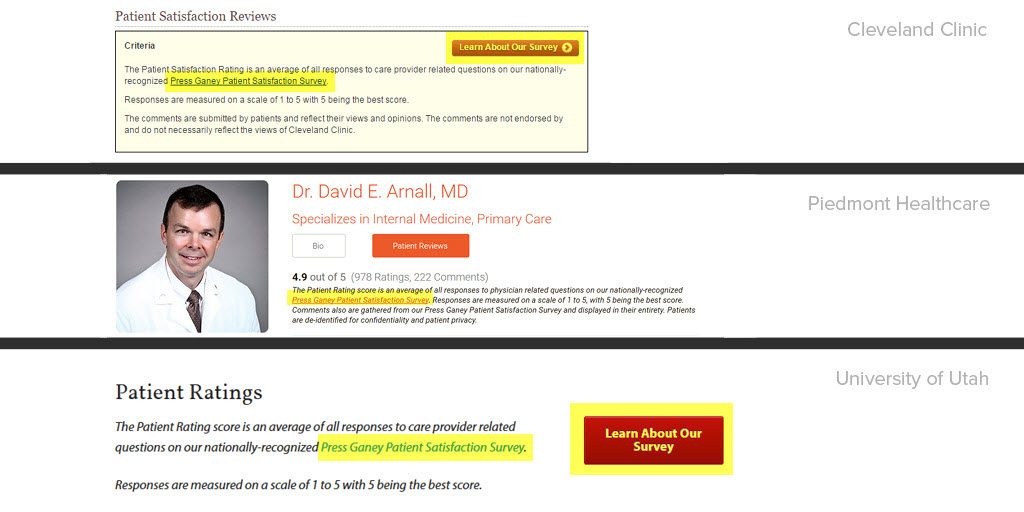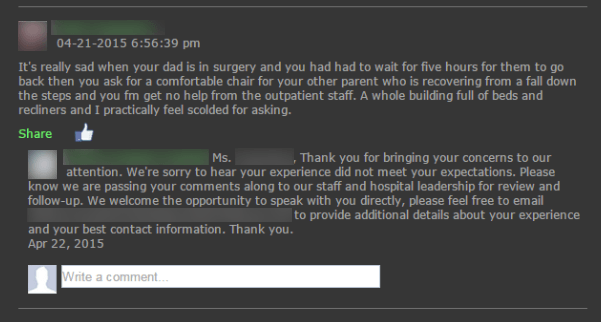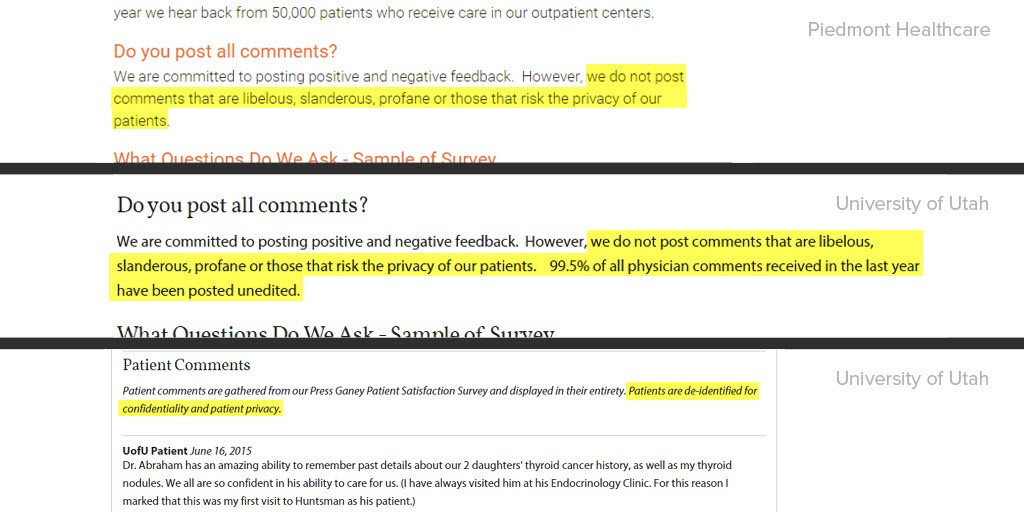There’s been a tremendous amount of interest among healthcare marketers recently around publishing physician ratings and reviews on physician profiles. And for good reason. When done right, organizations often see a number of benefits including an SEO boost, reduced reliance on paid promotion, more engagement with physician profiles, and improved patient acquisition. I covered some of this in my previous blog post, and wrote about it more extensively in our new eBook, Online Physician Promotion for the Healthcare Marketer. In this post, however, I’d like to cover a few important aspects about physician ratings and reviews you may not think about immediately.
If you plan to implement physician ratings and reviews on your website, there are some things you need to make sure you have in place before you go live. Getting these things taken care of will ensure that your physician ratings and reviews are trusted by site visitors and provide tangible value to your organization.
1. Link to the description of how the ratings and reviews are collected
Despite legislative mandates to publish it, consumers don’t necessarily trust the quality information provided on many hospital and government websites. For this reason, it’s imperative that if you’re considering adding ratings and reviews to your physician profiles, you provide a prominent means for visitors to access a description of how these ratings are solicited, acquired and published.
A quick survey of some of the better implementations shows how this is accommodated right on the physician profiles. Don’t forget to do this on your own!

2. Determine the threshold for publishing ratings and reviews
There’s nothing stopping you from publishing ratings as they come in, but try to avoid publishing a low number to a physician’s profile. Most organizations choose to start publishing ratings for a given physician only when they have accumulated a suitable number of ratings and reviews. For instance, The University of Pittsburgh Medical Center (UPMC) recently announced that they would start publishing physician ratings on their website and have decided that a given physician will need 30 reviews within 18 months before they will appear on the site. And they are not alone.

There are a number of reasons to do this, but two important ones stand out:
- Having a physician with only one or two ratings can suggest to consumers that s/he is not popular with patients. Waiting to publish until their are a sufficient number of reviews avoids this.
- Having only a few reviews can present a distorted view of the physician. A couple of low or high ratings (or positive/negative reviews) can skew the results significantly. Waiting for a statistically valid number of ratings and reviews ensures site visitors have a clearer, more useful and valid picture of the physicians.
3. Do not filter negative reviews
One of the largest issues hospitals, health systems, and physicians struggle with is the “What if?” scenario involving negative reviews. The fear about publishing negative reviews is often palpable. And it’s understandable. Most marketers have an instinctive drive to protect the brand, and are worried about publishing a negative review that reflects poorly on the physician, the organization, the system, etc…
Get over it.
If you are publishing physician ratings and reviews on your website, you have ethical and moral obligations to include the negative ones as well. There may even be legal implications to cherry-picking only the best ratings and reviews for publication.
Lets face it, negative reviews happen. And to some extent, consumers even expect to see a distribution of positive and negative reviews. But if you fear a huge deluge of negativity, you may be overreacting. As the Harvard Health Blog put it, “Studies suggest that most – between 65% and 90% – of online patient reviews are positive.” And it’s not just one study. A famous study from 2012 looked at third-party physician ratings websites and supports the same conclusion:
The study found that, on average, physicians received a quality rating of 3.93 out of 5. Nearly half received a perfect 5 rating.
–The Washington Post
If you do implement physician ratings only to discover that some physician reviews are overwhelmingly negative, it’s your opportunity to investigate, understand, and improve. That’s a much less frightening prospect for most marketers than letting negative reviews continue to spread by word of mouth or on third party websites, where they fester and damage the brand. At the end of the day, negative reviews may be your opportunity to identify and fix problems.
And of course, don’t forget to include some verbiage about publishing all your reviews, including negative ones, in your description about how ratings and reviews are collected and published.

4. Determine your response policy prior to having a problem
As touched on above, you should expect to get some amount of negative reviews…and it’s important to plan for how you’re going to handle these prior to launching ratings and reviews on your site. In fact, it’s probably a good idea to figure this out even if you aren’t launching ratings and reviews on your website. The fact is that your physicians are being reviewed elsewhere, and it’s a good idea to stay on top of this (see the Physician Promotion eBook for more on this).

I usually recommend organizations start by determining whether or not to let a negative rating or review stand on its own. Not every negative review deserves a response, but if it’s a path you want or need to tread, make sure you staff appropriately and figure out your approach before you have a problem. Some things you’ll want to figure out include:
- Identify who a response will come from. Consider patient advocates (or others in similar roles). Avoid having physicians personally respond. They need to focus on the work of healing and not on personally responding to negative reviews. Additionally, they are likely not experts in this domain and can easily make a bad situation worse.
- Be clear about what you want to accomplish in your responses. Be cautious if your goal is to counter and disprove every negative review. I recommend a touch-and-turn approach that reassures the audience that you’ve heard the problem and are invested in learning more about it offline. Be careful of language that seems to deny patients their own experience. Consider something like the following:
- I’m sorry you did not have a positive experience at our hospital/office/clinic. I’d like to learn more about what happened and how we can better serve our patients. Would you mind contacting me at our patient advocate office so we can discuss? You can reach me at 555.555.5555. -Mary
Such verbiage lets the patient own his or her experience, shows readers that you’re listening and want to learn more, and moves the conversation offline and out of the public theater. These are all wins for your organization, and not just from a reputation management perspective. This type of follow-through can surface important opportunities for improvement that you might otherwise miss.
5. Establish a publication policy for reviews that contain PHI
Earlier in this post I covered the importance of not censoring negative reviews, and I suggested that once you go down the path of publishing ratings and reviews, you have an obligation to publish ALL reviews. While I stand by this advice, there is one important exception we need to allow for: reviews that contain personally identifiable health information (PHI).
When it comes to these, you have two options: editing out any PHI from reviews, or withholding such reviews from publication.

Both options come with complications you’ll have to work through. If you edit a review to remove PHI prior to publishing it, I submit that you have an obligation to disclose this fact when you publish the review. A simple, “This review has been edited to remove personally identifiable health information” may suffice. In your disclaimer you can even include a link to your complete explanation about how and under what conditions posts are edited.
The other option is to exclude from publication any post that contains PHI. If you go this route, you should disclose the fact that you aren’t publishing posts containing PHI. Readers deserve to know that they are getting only a subset of reviews when using them to evaluate physicians. And be warned, this approach may exclude a sizable number of reviews from your site.
Lastly, if you’re excluding reviews, you’ll need to figure out what you want to do with the corresponding ratings. If you’re removing a large number of reviews, but publishing the accompanying ratings, the ratio between ratings and reviews may look suspiciously unbalanced to prospective patients.
While there’s not one correct approach for every organization, you’ll need to plan on scrubbing personally identifying information from reviews. Some vendor solutions can even help with this through automation and workflows for your staff. And it’s really the only way to make the most out of your investment in publishing ratings and reviews on your site.
Next Steps
As you plan for physician ratings and reviews on your site, you’re going to have more questions and considerations. Check out the Physician Promotion eBook for more great resources on this. Or if you’re ready to work with someone who can help you understand your options and move forward, contact us.

